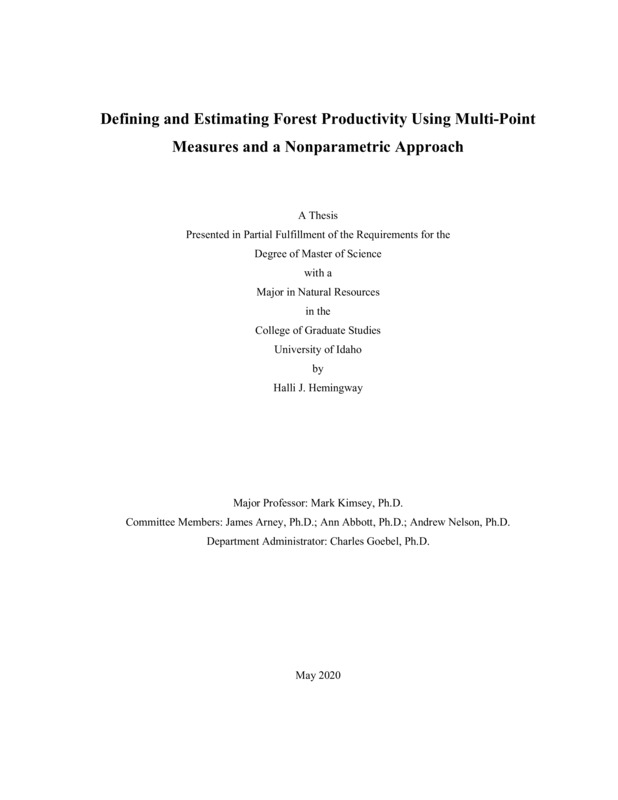Defining and Estimating Forest Productivity Using Multi-Point Measures and a Nonparametric Approach
Hemingway, Halli J.. (2020-05). Defining and Estimating Forest Productivity Using Multi-Point Measures and a Nonparametric Approach. Theses and Dissertations Collection, University of Idaho Library Digital Collections. https://www.lib.uidaho.edu/digital/etd/items/hemingway_idaho_0089n_11787.html
- Title:
- Defining and Estimating Forest Productivity Using Multi-Point Measures and a Nonparametric Approach
- Author:
- Hemingway, Halli J.
- ORCID:
- https://orcid.org/0000-0001-6297-5493
- Date:
- 2020-05
- Keywords:
- 10-Meter Site Index Douglas-fir Forest Productivity Nonparametric Site Index Site-growth
- Program:
- Natural Resources
- Subject Category:
- Forestry
- Abstract:
-
Accurate measures of forest site productivity are essential for forest management planning. The most common measure of site productivity is breast height age site index (BHASI) – the expected height at a reference age. Error from including early growth in productivity estimates, and limited applicability of any one BHASI model warrant development of alternative methods. Exploring alternatives may only be necessary if regional BHASI models are not accurately predicting growth rates.
We compared modeled height growth rates for Rocky Mountain Douglas-fir (Pseudotsuga menziesii var. glauca) to felled-tree measurements to evaluate relative performance of a regional BHASI model. An orthogonal sampling design ensured samples were collected across a range of site factors known to influence Douglas-fir growth rates. Growth rates for each 10 m section were calculated and compared to BHASI modeled growth rates. The regional BHASI model under-predicted growth rates from breast height to 30 m. Observed growth rates from 10 to 30 m accounted for the majority of under-prediction relative to BHASI modeled growth rates. An alternative multi-point method of defining site productivity (10-meter site index) is described.
We explored the accuracy of productivity predictions using 10-meter site index and a nonparametric approach. Using climate, soil, and topographic data along with felled tree measurements, we compared five possible models to estimate forest productivity. Model parameters, performance, and predictions were compared. Twelve validation sites were used to test accuracy of model predictions. Model performance was significantly improved when smoothing span values were optimized and elevation was added as a predictor. A four-predictor nonparametric model with a bias-corrected Akaike information criterion optimized smoothing span value produced the most accurate results and was used to produce forest productivity maps for the study area. The large resolution of currently available climatic data and the complex nature of the study area landscape necessitate a topographic variable for accurate productivity predictions. Defining productivity using 10-meter site index and estimating landscape scale productivity using an optimized nonparametric approach produced the most accurate forest productivity estimates.
- Description:
- masters, M.S., Natural Resources -- University of Idaho - College of Graduate Studies, 2020-05
- Major Professor:
- Kimsey, Mark
- Committee:
- Arney, James ; Abbott, Ann ; Nelson, Andrew
- Defense Date:
- 2020-05
- Identifier:
- Hemingway_idaho_0089N_11787
- Type:
- Text
- Format Original:
- Format:
- application/pdf
- Rights:
- In Copyright - Educational Use Permitted. For more information, please contact University of Idaho Library Special Collections and Archives Department at libspec@uidaho.edu.
- Standardized Rights:
- http://rightsstatements.org/vocab/InC-EDU/1.0/

